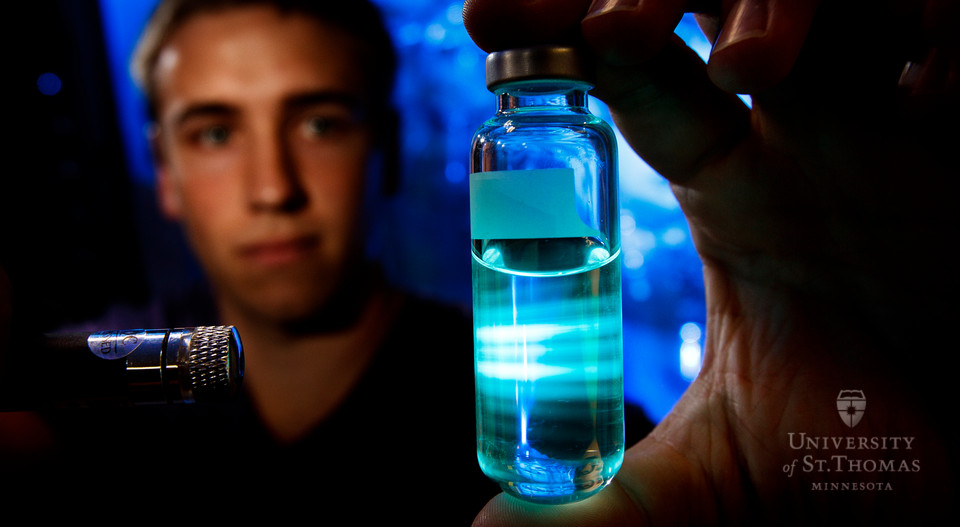Nick Serratore points a small flashlight at the counter in an Owens Science Hall chemistry lab and thumbs the "on" button with his right hand.
Nothing happens.
Smiling, he picks up a vial of pale, yellow-tinged liquid in his left hand and pivots the light so that it shines through the glass sides of the vial. Instantly the liquid inside glows an intense aqua, reacting to the invisible UV rays from Serratore's penlight. These are chemiluminescent molecules and Serratore is about to spend the next hour standing under my, very visible, photo lights and explaining to an increasingly confused photographer exactly what he's spent the last three years working on under the direction of Dr. Tom Ippoliti.
Nick Serratore is a patient man.
On TV and in PR photography all things science must glow blue (thank you, CSI), so I stick a small flash, gelled blue, inside Serratore's lab hood (essentially his glass-enclosed working area). The light will be tripped by a radio trigger mounted to my camera. When I push the shutter button, the strobe goes off and fills the hood with a blue glow (you can see it in the background above). Next I point another light, with the power turned way down, at Serratore's face. We'll take a variety of shots, some focusing on Serratore's face, others on the chemicals he works with. By varying the power of the lights and the focus of the camera, I'll be able to shift visual attention easily between the two. Finally I point another strobe at Serratore's left hand, adding just enough light to keep his hand from becoming a silhouette.

I work with Serratore for about two minutes to get the vial and the flashlight into the right relationship with his face and we start taking pictures. What you see at the top of this article is one of my favorite shots from the session.
But we're not done.
Serratore sticks an Erlenmeyer Flask inside the hood while I set my camera on a tripod pointed at the flask. When I give the signal he pours two vials of chemicals into the container. As soon as they touch they burst into the same aqua glow as the chemicals in the smaller vial did earlier in our shoot. But this time there's much more of the stuff and it glows even brighter - for about 10 seconds.
The key to making a good image of these glowing chemicals is to balance the light they emit for that 10 seconds with the light from my blue-gelled flash. Too much power from my flash and I drown out the natural color coming from the flask. Not enough power and everything in the frame except for the chemicals goes black and the viewer loses any sense of place - including the outline of most of the flask.
Lucky for me Serratore gives me two chances - first with a demo mixture so I can set a proper exposure for the glow from the chemicals, then again with my strobes in place. That second attempt is what you see at right.
Nick Serratore? He's headed off to UW Madison to pursue his Ph.D. Me? I'm headed back to Loras Hall to file my images of luminescent molecules and Nick Serratore.
Editor's note: Nick Serratore's research was funded in part by a Summer Housing grant. He also traveled thanks to a Student Travel grant.
Read More from the Depth of Field blog.







